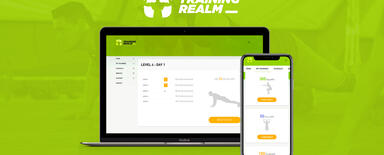
Achieve Your Business Objectives With a Good Design
In Droptica, the development team works closely with the designer. Close cooperation and unrestricted contact allow building websites that not only are visually attractive and perfected in terms of UX and UI, but also perfected in terms of programming. In this post, I will describe the process which we follow when working on projects and the way the cooperation between the designer, programmers and testers works in practice.
What do we do in Droptica?
Droptica is a Drupal agency whose main activities are focused on building and development of software based on Drupal and Symfony. For many years we have been working on the creation of websites from scratch, but we are also engaged in the ongoing maintenance of websites operating on the basis of these technologies. In both cases, we provide customers with high-quality results. In this post, I will focus only on comprehensive solutions, where we are responsible for the entire product – starting from the customer’s concept and ending with final deployment. Such a process includes the preparation of the UX concept, on the basis of which a graphic design (UI) is created. The visual design developed and approved by the customer is deployed and changed into a working web page.
What does the team working on the project look like and how are the competencies divided?
To provide the customer with the best product, we work as a team. Complex projects, software certainly being one of them, require specialists who will perform work at different stages. Such a team comprises persons or groups responsible for issues such as UX/UI, programming and tests. The designer is responsible for the analysis of customer needs and guidelines, preparation of the concept of information architecture for each subpage, layout and hierarchy of components, and for the preparation of prototypes and subsequent usability tests. The result of this work is the creation of wireframes, on the basis of which the final UI design is created. Programming matters are the responsibility of the programmers who create the technological part of the application. A tester is a person responsible for testing the software and detecting bugs. The team is in contact and cooperates closely at each stage of the project.

What is the role of the designer in the process of creating an application?
In Droptica, the UX designer is in contact with the programmer already at the design stage. This makes it possible to select the best possible technical solutions. The combination of these complementary competencies allows creating designs that are visually attractive and easy to use for the user. An example of a direct benefit resulting from such cooperation is the perfect operation of the system on all types of mobile and stationary devices, regardless of the resolution and size of the screen. The solutions proposed by the designer are immediately confronted with technical possibilities and possible technical problems are detected already at the beginning. This way, they do not delay the work at a later stage of deployment. The entire design process is conducted in accordance with an Agile methodology based on SCRUM. Owing to daily meetings and consultations the project is developing very quickly, before the customer’s eyes, who has insight into the process at each stage.
In the last phase, the design is thoroughly checked by the tester in the prepared test environment. The result of the developers’ work forms the basis for checking the operation of the applications and detecting possible bugs. Also at this stage, the designer works closely with the team and pays attention to the visual quality of the created design. Owing to a close relationship within the team minor bugs are detected and quickly forwarded to the programmer. It is important for us that the design approved by the customer is deployed with maximum accuracy. The designer promotes the Pixel Perfect approach, where the depiction of the design must be as
precise as possible.
The designer’s tools in Droptica
The designer's team has an array of design tools and tools supporting work and communication. The UX design, i.e. wireframes and first screens are created in UXpin. This is an excellent tool that allows us to create working prototypes quickly, which we can share with the customer. UXpin allows to show the interaction between the elements of the application and gives the possibility of testing the concept of the website at the first stages of the UX design. It is an effective tool, both in terms of the presentation for the customer, but also for consultations within the team. By using it the designer is able to show what result is being expected from the programmer.
To learn about the customer’s opinion, we use InVision for the prepared design. This practical software allows the customer to share comments to the specific subpages of the application in a comfortable manner. The discussions held with the use of InVision regarding specific graphic elements and the simple system for adding comments make the work much easier and faster. Both programmers and testers have access to this tool and may also participate in the creation of the final design.
We create the UI design using the Adobe Creative Cloud programmes. Adobe XD, illustrator and Photoshop. These programs allow us to deliver high-quality graphics that can be efficiently encoded into a working website. The designer provides screens’ designs using the Zeplin tool, which allows programmers’ full access to the created design. The deployment of a design in the Pixel Perfect style, using this tool, is significantly streamlined. It makes measuring of the distance between the elements and downloading CSS styles from the created design very simple.
There is no substitute for face-to-face meetings, but we find Slack a very convenient way of communication. The quick exchange of questions or files provided by this platform is another tool which facilitates work. We also encourage the customer to communicate with the team directly. The messenger enables quick communication, effectively replacing email as the basic tool for sending written messages.
What are the benefits for customer resulting from the use of a complete team?
The main advantage of using a complete team comprising designers, programmers and testers are the quality of the received software. Only a closely cooperating team that is familiar with its skills is able to achieve the best results.
Close cooperation between the designer and the developer allows to eliminate bugs quickly and at the right stage, and find the best technological solutions at the beginning of the project effectively. The influence of programmers on good User Experience is often forgotten, by limiting good UX to prepare wireframes and mock-ups. The way the applications operate, loading time of subpages, optimisation for individual devices and platforms are mainly the responsibility of programmers, and to a large extent, it also affects user experience. If the design team is not in contact with the programmers, the final result may not be satisfactory.
Cooperation with testers also brings positive results, especially during deployments. Quick detection of visual bugs by the tester and forwarding them to the designer determines the design. In Droptica, at the final stage of the project, the tester consults with the designer the operation and appearance of questionable elements.
The benefit of such a model of completion is to entrust a project to the design team whose members know each other and which will perform the work efficiently. We avoid problems with communication within the team and respond to emerging issues quickly. When a team is composed of people who do not know each other, sometimes such communication takes a long time, which in the case of a complex project is not desirable.
If you want your project to be handled by a dedicated, professional team, write to us. We look forward to discussing your project!













